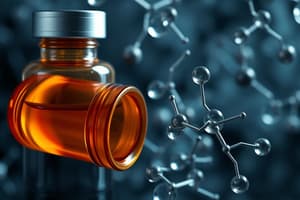Podcast
Questions and Answers
How do hormones influence various functions in the body?
How do hormones influence various functions in the body?
- By acting as structural components of organs
- By directly altering neural pathways
- As chemical messengers regulating growth, metabolism, and sexual development (correct)
- Through electrical impulses transmitted across cells
Which hormone is primarily responsible for the development of male sex characteristics?
Which hormone is primarily responsible for the development of male sex characteristics?
- Progesterone
- Estrogen
- Cortisol
- Testosterone (correct)
According to the challenge hypothesis, in what situations do male testosterone levels tend to rise?
According to the challenge hypothesis, in what situations do male testosterone levels tend to rise?
- When facing challenges to mating and reproductive success (correct)
- In response to threats from predators
- During periods of rest and relaxation
- In environments with low social interaction
What is the role of cortisol in the human body?
What is the role of cortisol in the human body?
According to the dual-hormone hypothesis, when is the relationship between testosterone and status-seeking behavior strongest?
According to the dual-hormone hypothesis, when is the relationship between testosterone and status-seeking behavior strongest?
What does psychophysiology primarily study?
What does psychophysiology primarily study?
Which of the following is directly measured by skin conductance responses (SCR)?
Which of the following is directly measured by skin conductance responses (SCR)?
In Lykken's (1957) study, how did psychopaths differ from controls in their SCR to an impending shock?
In Lykken's (1957) study, how did psychopaths differ from controls in their SCR to an impending shock?
In the context of avoidance learning, what is the primary task?
In the context of avoidance learning, what is the primary task?
According to the 'fearlessness' theory, what do consistently low SCRs indicate?
According to the 'fearlessness' theory, what do consistently low SCRs indicate?
What type of brain activity is often observed in offenders, especially in the frontal lobe, according to EEG studies?
What type of brain activity is often observed in offenders, especially in the frontal lobe, according to EEG studies?
What relationship between resting heart rate and antisocial behavior have studies consistently found?
What relationship between resting heart rate and antisocial behavior have studies consistently found?
What did the Mauritius study reveal about the association between heart rate and aggression?
What did the Mauritius study reveal about the association between heart rate and aggression?
According to the sub-optimal arousal (sensation-seeking) theory, what type of behavior might hypoactive individuals engage in to raise their arousal levels?
According to the sub-optimal arousal (sensation-seeking) theory, what type of behavior might hypoactive individuals engage in to raise their arousal levels?
In Lykken's mental maze experiment, what was the ratio of 'correct choices' to 'punished choices'?
In Lykken's mental maze experiment, what was the ratio of 'correct choices' to 'punished choices'?
What do EEG recordings measure in the brain?
What do EEG recordings measure in the brain?
How does the 'fearlessness' theory explain the relationship between low SCRs and socialization?
How does the 'fearlessness' theory explain the relationship between low SCRs and socialization?
In the context of hormone influence on behavior, how does testosterone affect social dominance, according to the provided content?
In the context of hormone influence on behavior, how does testosterone affect social dominance, according to the provided content?
What is the effect of high cortisol levels, according to the information provided?
What is the effect of high cortisol levels, according to the information provided?
According to the information on skin conductance responses, what does an increased SCR typically reflect?
According to the information on skin conductance responses, what does an increased SCR typically reflect?
How might a hypoactive autonomic nervous system (ANS) affect behavior, according to the low arousal theory?
How might a hypoactive autonomic nervous system (ANS) affect behavior, according to the low arousal theory?
According to the information provided, what is the primary relationship between challenges to status and testosterone levels, as described in the challenge hypothesis?
According to the information provided, what is the primary relationship between challenges to status and testosterone levels, as described in the challenge hypothesis?
In Lykken's (1957) study, which measured avoidance learning, how was avoidance learning performance related to psychopathy?
In Lykken's (1957) study, which measured avoidance learning, how was avoidance learning performance related to psychopathy?
According to research on resting heart rate and antisocial behavior, what might a lower resting heart rate indicate?
According to research on resting heart rate and antisocial behavior, what might a lower resting heart rate indicate?
How do sex hormones, such as testosterone, directly influence behavior related to crime?
How do sex hormones, such as testosterone, directly influence behavior related to crime?
Flashcards
Hormones
Hormones
Chemical messengers regulating growth, metabolism, and sexual development.
Testosterone
Testosterone
Hormone responsible for developing male sex characteristics.
Challenge Hypothesis
Challenge Hypothesis
Theory that links testosterone levels to male mating and reproductive success.
Cortisol
Cortisol
Signup and view all the flashcards
Dual-Hormone Hypothesis
Dual-Hormone Hypothesis
Signup and view all the flashcards
Psychophysiology
Psychophysiology
Signup and view all the flashcards
Skin Conductance Response (SCR)
Skin Conductance Response (SCR)
Signup and view all the flashcards
Fearlessness Theory
Fearlessness Theory
Signup and view all the flashcards
Electroencephalograms (EEGs)
Electroencephalograms (EEGs)
Signup and view all the flashcards
Resting Heart Rate
Resting Heart Rate
Signup and view all the flashcards
Resting heart rate & antisocial behaviour
Resting heart rate & antisocial behaviour
Signup and view all the flashcards
Hypoactive
Hypoactive
Signup and view all the flashcards
Low Arousal Theory
Low Arousal Theory
Signup and view all the flashcards
Avoidance Learning Task
Avoidance Learning Task
Signup and view all the flashcards
Study Notes
- Psychological Explanations of Criminal Behavior are explored through biopsychology, specifically psychophysiology.
Hormones
- Chemical messengers that regulate growth, metabolism, and sexual development.
- Two main types: Sex hormones and Stress hormones.
Sex Hormones
- Testosterone is responsible for the development of male sex characteristics, originating from testes, ovaries, and adrenal glands.
- Testosterone is linked to social dominance.
Challenge Hypothesis
- Male testosterone levels increase in situations challenging mating and reproductive success.
- This increase indirectly contributes to violence.
- Challenges to status elevates testosterone, leading to status-seeking, risk-taking, and aggression.
- Social dominance increases the risk of violence.
Cortisol
- A hormone released from the adrenal gland in response to stress.
- High cortisol levels may heighten behavioral responses to minor provocations.
- Low cortisol levels may lead to an underappreciation of the consequences of aggression.
Dual-Hormone Hypothesis
- The relationship between testosterone and status-seeking behavior is stronger when cortisol levels are low.
Psychophysiology
- Involves the study of the relationship between physiological activity and psychological states.
- Areas of examination include:
- Skin Conductance Responses (SCR)
- Brain wave activity
- Heart rate
- The nervous system is divided into the central and peripheral nervous systems, with the peripheral further divided into somatic and autonomic (sympathetic and parasympathetic) systems.
Skin Conductance Response (SCR)
- Measures the flow of electrical current across the skin.
- Directly measures sympathetic (ANS) activity, indirectly measuring emotion.
- Increased SCR reflects heightened emotional arousal, such as anxiety or fear.
Lykken (1957) Study
- Studied Skin Conductance Response (SCR) to an impending shock and avoidance learning task.
- SCRs in anticipation of shock were significantly lower in people with psychopathy compared to controls, indicating poor conditionability related to psychopathic tendencies.
- Participants learned to avoid aversive stimuli in an avoidance learning task, finding psychopathic offenders performed worse than non-psychopathic offenders and controls.
Fearlessness Theory
- Low SCRs indicate fearlessness, which diminishes the effectiveness of punishment which leads to poor socialization.
- Fearlessness disinhibits behavior.
Electroencephalograms (EEGs)
- Recordings of brain electrical activity ('brain waves').
- Includes Delta (0-4 Hz), Theta (4-8 Hz), Alpha (8-12 Hz), and Beta (13-30 Hz) waves that indicate faster wave activity.
- A large proportion of offenders have abnormal EEGs, especially in the frontal lobe.
- Offenders show relatively more slow wave activity.
Resting Heart Rate
- Heart rate level under conditions of non-exertion.
- Studies consistently find a negative relationship between resting heart rate and antisocial behavior.
Mauritius Study (Raine, Venables, & Mednick, 1997)
- Explored the Association between Heart Rate & Aggression.
- It was found that 66% were aggressive when heart rate was low.
- As opposed to when heart rate was high, only 35% were aggressive.
Low Arousal Theory
- Sub-optimal arousal (sensation-seeking) theory.
- Suggests there is an "optimal" level of arousal, when too much or too little arousal is unpleasant.
- Some people have chronically hyperactive or hypoactive ANS.
- Those who are hypoactive tend to engage in sensation-seeking behavior to raise arousal.
- This may lead to "risky" and antisocial behavior.
Studying That Suits You
Use AI to generate personalized quizzes and flashcards to suit your learning preferences.





